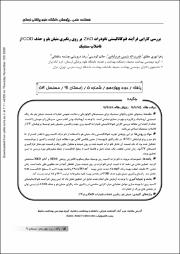| dc.contributor.author | Noorimotlagh, zahra | en_US |
| dc.contributor.author | Shams, ghodratollah | en_US |
| dc.contributor.author | Godini, hatam | en_US |
| dc.contributor.author | Darvishi, reza | en_US |
| dc.date.accessioned | 1399-08-21T21:41:59Z | fa_IR |
| dc.date.accessioned | 2020-11-11T21:42:00Z | |
| dc.date.available | 1399-08-21T21:41:59Z | fa_IR |
| dc.date.available | 2020-11-11T21:42:00Z | |
| dc.date.issued | 2013-02-01 | en_US |
| dc.date.issued | 1391-11-13 | fa_IR |
| dc.identifier.citation | Noorimotlagh, zahra, Shams, ghodratollah, Godini, hatam, Darvishi, reza. (2013). Study of ZnO nano particles photocatalytic process efficiency in decolorization of methylene blue and COD removal from synthetic wastewater. scientific magazine yafte, 14(5), 51-61. | en_US |
| dc.identifier.issn | 1563-0773 | |
| dc.identifier.uri | http://yafte.lums.ac.ir/article-1-1111-en.html | |
| dc.identifier.uri | https://iranjournals.nlai.ir/handle/123456789/483130 | |
| dc.description.abstract | Background : Effluents containing synthetic dyes are hazardous to ecological systems and public health. Methylene blue is an important chemical aromatic dye which commonly used in textile industries. Due to being aromatic, it is often toxic, carcinogenic and mutagenic. The goal of this study was to investigate the efficiency of ZnO nano particles photocatalytic process for decolorization of methylene blue by UV irradiation from synthetic textile wastewater.
Materials and Methods: In this study methylene blue photocatalytic decomposition using Ultraviolet (UV) irradiation and zinc oxide nano particles having less than 50 nm in diameter was surveyed. A batch-through Plexiglass reactor having two compartment used to conduct the experiments. Wastewater was flowed to the compartment which contains of nano ZnO stabilized glasses. UV lamps were installed at another compartment. The variables of the study included: exposure time, color concentration, light intensity, and lamp distance to the catalyst surface.
Results: ZnO nano particles characteristics were determined by Scanning Electron Microscope (SEM) and X-ray diffraction (XRD) analysis. Images showed that stabilizes nano particles on glass, their porosity remains in the optimal level. Optimium values for exposure time 120 minutes, color concentration 25 mg/l, light intensity 3950 μW/cm2, and distance to the catalyst surface 1 cm were achieved. At the optimal condition, methylene blue decolorization and COD removal was achieved 92.2% and 75% respectively
Conclusion: Regarding the conducted experiments, the results of this studyshowed that ZnO/UV photocatalytic process has a significant efficiency in dye decolorization and COD removal. This method could be applied in the full scales. | en_US |
| dc.format.extent | 381 | |
| dc.format.mimetype | application/pdf | |
| dc.language | English | |
| dc.language.iso | en_US | |
| dc.relation.ispartof | scientific magazine yafte | en_US |
| dc.relation.ispartof | مجله علمی پژوهشی یافته | fa_IR |
| dc.subject | Methylene blue | en_US |
| dc.subject | Wastewater decolorization | en_US |
| dc.subject | ZnO nano particles | en_US |
| dc.subject | UV radiation. | en_US |
| dc.title | Study of ZnO nano particles photocatalytic process efficiency in decolorization of methylene blue and COD removal from synthetic wastewater | en_US |
| dc.type | Text | en_US |
| dc.type | Research | en_US |
| dc.contributor.department | Lorestan University of Medical Sciences, Khorramabad, Iran | en_US |
| dc.contributor.department | Lorestan University of Medical Sciences, Khorramabad, Iran | en_US |
| dc.contributor.department | Lorestan University of Medical Sciences, Khorramabad, Iran | en_US |
| dc.contributor.department | Tarbiat Modarres University, Tehran, Iran. | en_US |
| dc.citation.volume | 14 | |
| dc.citation.issue | 5 | |
| dc.citation.spage | 51 | |
| dc.citation.epage | 61 | |





